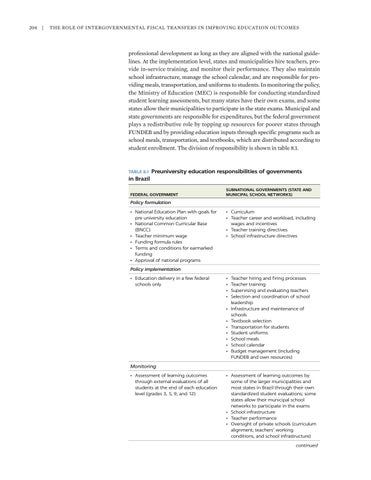204 | The Role of Intergovernmental Fiscal Transfers in Improving Education Outcomes
professional development as long as they are aligned with the national guidelines. At the implementation level, states and municipalities hire teachers, provide in-service training, and monitor their performance. They also maintain school infrastructure, manage the school calendar, and are responsible for providing meals, transportation, and uniforms to students. In monitoring the policy, the Ministry of Education (MEC) is responsible for conducting standardized student learning assessments, but many states have their own exams, and some states allow their municipalities to participate in the state exams. Municipal and state governments are responsible for expenditures, but the federal government plays a redistributive role by topping up resources for poorer states through FUNDEB and by providing education inputs through specific programs such as school meals, transportation, and textbooks, which are distributed according to student enrollment. The division of responsibility is shown in table 8.1.
TABLE 8.1 Preuniversity
education responsibilities of governments
in Brazil FEDERAL GOVERNMENT
SUBNATIONAL GOVERNMENTS (STATE AND MUNICIPAL SCHOOL NETWORKS)
Policy formulation • National Education Plan with goals for pre university education • National Common Curricular Base (BNCC) • Teacher minimum wage • Funding formula rules • Terms and conditions for earmarked funding • Approval of national programs
• Curriculum • Teacher career and workload, including wages and incentives • Teacher training directives • School infrastructure directives
Policy implementation • Education delivery in a few federal schools only
• • • • • • • • • • •
Teacher hiring and firing processes Teacher training Supervising and evaluating teachers Selection and coordination of school leadership Infrastructure and maintenance of schools Textbook selection Transportation for students Student uniforms School meals School calendar Budget management (including FUNDEB and own resources)
Monitoring • Assessment of learning outcomes through external evaluations of all students at the end of each education level (grades 3, 5, 9, and 12)
• Assessment of learning outcomes by some of the larger municipalities and most states in Brazil through their own standardized student evaluations; some states allow their municipal school networks to participate in the exams • School infrastructure • Teacher performance • Oversight of private schools (curriculum alignment, teachers’ working conditions, and school infrastructure) continued






